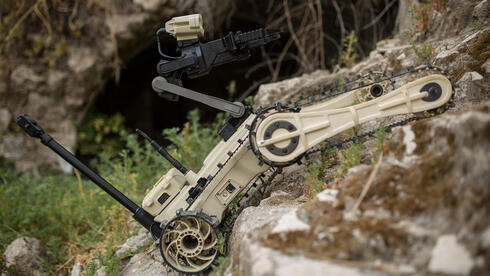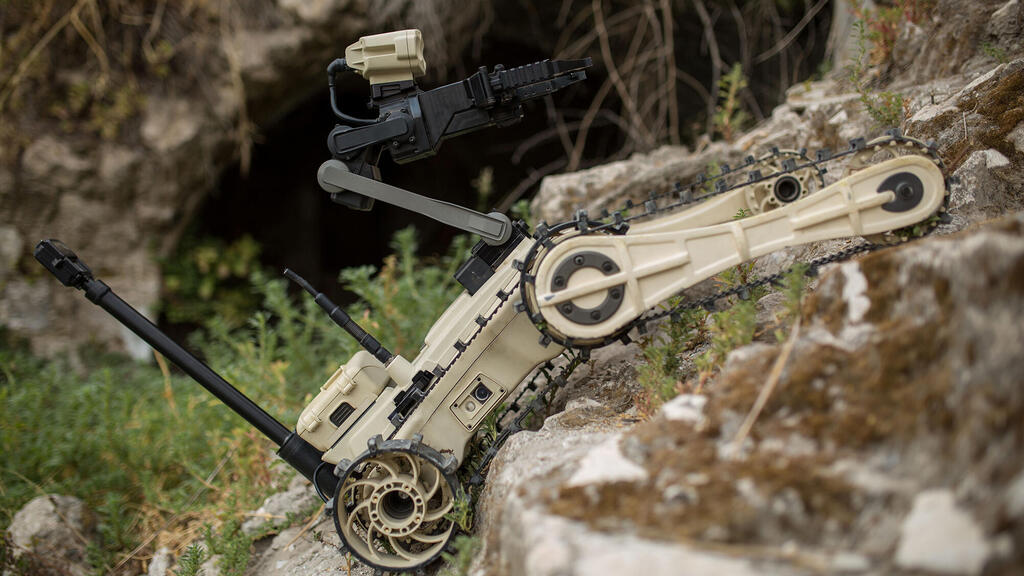
Robots of war: IDF's cutting-edge tech transforms Gaza battlefield
From remote-controlled bulldozers to explosive drones, unmanned tools lead the fight against Hamas.
Ten and a half months of war in Gaza have accelerated a years-long trend of integrating robots and unmanned tools into the routine operational activities of IDF units. After almost two decades of research and development, trial and error, closing technological gaps, and adapting to the psychological barriers faced by soldiers, Gaza has become the densest area in the world where robots and remotely operated tools are used as weapons of war, including for observation, tracking, ambushing, and more.
The arsenal of unmanned tools used by the IDF in Gaza is diverse, much of it classified. These weapons include robots that can cover kilometers exploring Hamas tunnels, climb stairs, jump over obstacles, and transmit real-time video footage to their operators, who control them using a touchscreen or joystick. Other robots lead armored and infantry columns along traffic routes to detect powerful explosives planted beneath them, sometimes even under a layer of asphalt, set to ambush maneuvering forces.
Absorbing most of the fire
A key unmanned tool used by the army's engineering units in this endless war is called "Panda." It appears no different from any ordinary D-9 bulldozer manufactured by the American company Caterpillar, used by the IDF for essential engineering work in the field. Elta, a division of Israel Aerospace Industries, enabled many of these bulldozers to be remotely operated.
In many operations conducted by the military in combat zones with terrorists, these bulldozers move at the head of the force and absorb most of the fire. The massive armor surrounding their cabins gives them the appearance of enormous steel fortresses moving on tracks. Nevertheless, terrorists aim RPG rockets, anti-tank missiles, and machine gun fire at them in an attempt to disable these iron monsters.
The ability to operate them remotely allows commanders in the field greater flexibility in their use. "There are tasks which in the past, they would have thought ten times before carrying out, due to significant concerns about loss of life. Now, these tools can be sent to do them as well. In the worst-case scenario, the [robot] is lost, but at least there won’t be a knock on the door of some family somewhere in the country. I wish there were more of them. Much more," said a security official involved in the matter in conversation with Calcalist.
In addition to the extensive purchase of new bulldozers from Caterpillar, the Ministry of Defense recently placed an order with Israel Aerospace Industries for around NIS 100 million ($26 million) for systems to convert these bulldozers into unmanned vehicles. "Since the first versions of Panda were released, we've made various updates, tweaks, and refinements to the system, achieving a technological breakthrough that allows us to maintain all the functionality of these bulldozers, while being operated remotely. This enables us to perform tasks with Pandas that we never imagined before, like uncovering powerful munitions embedded in roads designed to damage tanks or APCs moving over them," says an officer in the IDF's Ground Forces Technological Division.
"We can replicate how the D-9 has been converted to the Panda system and convert any manned vehicle into a remotely controlled robotic tool," says a senior defense industry official. "There is a lot of mature technology here that brings advanced navigation capabilities, the ability to overcome obstacles, and terrain mobility. It works well and saves lives."
Armored personnel carriers (APCs) used by the IDF have also undergone a similar conversion, enabling remote operation. There are only a few in operation currently, but as the war continues, their number has gradually increased. Remotely operated APC’s have been converted using older M-113 APCs, known in the IDF as "Cheetahs." Developed in the U.S. in the 1960s, their armor does not meet the threats posed by the modern battlefield. But the remote operation capabilities of these vehicles have brought the Cheetah back into some of the routine missions in Gaza in recent months.
Typically, Cheetahs are loaded with logistical equipment, food, and ammunition and sent to forces deep in the field. In recent weeks, such vehicles have been seen moving in the Rafah area. According to Palestinians in Gaza, these APCs are occasionally used for complex clearing operations, where they are heavily loaded with explosives, sent near buildings marked for demolition, and detonated remotely. "The ability to move such vehicles remotely opens up a wide range of capabilities, such as installing sensor systems which can gather data and information from the field and transmit it in real-time to their operators to improve intelligence and streamline and focus the combat," says a security official.
Remotely operated drones, including the “Maoz," developed by defense company Rafael, are also being utilized. The Maoz weighs about 3 kg and carries an explosive charge of about 400 grams. It can operate within a range of several hundred meters in an urban area, and thanks to a quiet electric motor, it can silently follow targets. When given the command, it dives at a speed of about 70 km/h toward its designated target and explodes on it.
The drone was designed by a former Rafael employee Yaki Hetz, now a 78-year-old retiree, who said the idea came to him after a battle he participated in during the Six Day War at Ammunition Hill. "Since that battle, I couldn't get the idea out of my head," he told Calcalist. "I realized then that there was a need for something like this, something that would do what a hand grenade does, only at greater distances and in places where it's difficult to throw grenades. My life's mission was to create such a tool that would help the IDF infantry forces. In this war, my son Gil served in Gaza as a reservist, and he and his comrades made extensive use of the Maoz, which for me is a closing of the circle," he said.
"Trying to minimize harm to civilians"
In addition to the Maoz, several special IDF units are also using the “Rooster” in Gaza, a small drone by Roboteam that, like a rooster, can hop over obstacles and quickly progress along its designated path. It can operate alone or with other Roosters, enter tunnels and confined spaces, document, warn of the presence of hazardous materials like toxic gasses, and more. The drone is surrounded by a kind of metal cage that allows it to roll in places where it cannot hover.
An older robot used by the IDF in Hamas tunnels is the MTGR (Micro Tactical Ground Robot) also from Roboteam. According to the manufacturer, it’s lightweight, equipped with advanced cameras that transmit 360-degree video, and characterized by high mobility in the field, including climbing stairs and overcoming obstacles.
Drones of various types and sizes of drones have been employed for years and have been an integral part of the IDF's operations. According to Dr. Liran Antebi from the Institute for National Security Studies (INSS), "The IDF and the Ministry of Defense are among the world's leading entities in investing in unmanned vehicle technologies, not only to keep soldiers out of danger but also to minimize the exposure of innocent civilians to harm during combat."
"This stems from moral considerations and also because Israel is subject to much more international scrutiny than other countries and needs legitimacy from the world during times of conflict."















